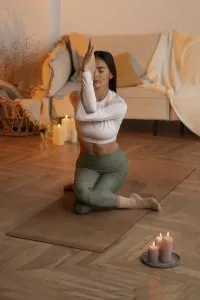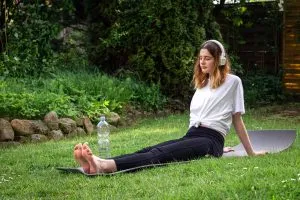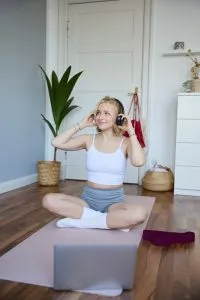I’ve been wondering lately what did the yogi’s of the past use to support them while they did yoga?
I can’t imagine it’d be very comfortable, maybe they used grass or feathers for a softer base.
I was intrigued to find out more about how they managed back then and what exactly they used.
If it’s something you’re interested to discover too, follow along.

History of Yoga Mats
While yoga has been around for thousands of years, using yoga mats is a fairly new idea.
When yoga was first discovered it was mainly about meditation and seated breathing, so they didn’t need anything in particular for support.
As time went on and more asana’s (physical postures) were included, the yogi’s used grass, sand, animal skins or basic cloths if they did need some padding underneath them.
These traditional yoga mats connected them to the earth, although they didn’t really give them much cushioning.

FAQ’s
Did ancient yogis use any props during their practice?
No, they used what came from nature but their practice was more focused on simplicity and being connected with the ground.
Why did they practice on grass or animal skins?
The yogic philosophy encouraged them to be in harmony with nature, so this lead to them using natural items for their yoga practice.
Doing their yoga on grass or sand made the feel close to nature and grounded.
The yoga blanket
As yoga gained popularity around the world it became more necessary to have a hygienic and portable surface to practice on.
In the 1930’s yogi’s started using blankets which were often made from wool or cotton to give them some comfort.
This way they had some protection from the cold, hard floors and it also gave them a little bit more padding than the animal skins and grass.

FAQ’s
Why did yogis start doing yoga indoors?
There were a few reasons including; keeping out of the weather, having some privacy and by this time yoga was becoming a structured exercise practice.
Did everyone use blankets, or were there other options?
Many practitioners used the blankets, although some still used cotton mats or whatever else they could find. As long as it was portable and non-slip they were using it.
The ‘sticky mat’
In the 1960’s yoga had really taken off in popularity around the world more than ever before.
One clever yogi adapted a piece of foam carpet underlay into a yoga mat!
This laid the foundation for the yoga mats we see around today.
Mind you, these ‘sticky mat’s’ didn’t last long after the 1980’s because they weren’t very hardwearing.
The foam deteriorated quickly and often tore when people were doing yoga poses.
Modern day yoga mats
The turning point in yoga mat evolution was in the 20th century, when the modern yoga mat was created.
With yoga being well known across the globe, more and more people taking it up, it became a necessity to create a dedicated non-slip yoga mat.
The first commercial yoga mats were made from PVC (polyvinyl chloride), which is a hardwearing and affordable material.
These mats were a hit being non-slip and they had a bit of cushioning, which was a huge improvement from the yoga blankets.
The only issue was the environmental impact and harmful chemicals in these mats, which resulted in lots of different producers creating yoga mats from other materials too.
Gillian Leyermeyer’s study discovered that “The mat offers and sanctions the space of yoga practice. A farewell of “see you on the mat” may reveal a sort of commitment and acknowledgement to the practice itself and to the community of practicing together”.

FAQ’s
When was the first commercial yoga mat introduced?
The lady who made her first ‘yoga mat’ to use during her yoga practice was Angela Farmer.
She is the lady who used some foam carpet underlay to cut out a yoga mat shape to use.
This inspired the creation of many more commercial yoga mats.

Why were PVC mats so criticised?
PVC is know to be great for underground piping but not so much for Yoga mats!
When yogis throw away their PVC mats, they will probably end up in landfill where they could take hundreds or even thousands of years to fully break down!
Also the chemicals in PVC are toxic when released into the ground.
Some practicioners also didn’t like the strong chemical smell from their PVC yoga mats.
Environmentally-Friendly Mats
Because there was so much concern from the yoga community about the PVC mats, there became an opportunity for businesses to create yoga mats from eco-friendly materials.
A new wave of mats included: jute, cork, natural rubber, TPE (thermoplastic elastomer).
These quickly became popular, offering us a choice that also supported the environment and were biodegradable.
They still had the benefits like being non-slip and with cushioning too, so many turned away from PVC for these options.

FAQ’s
What are the advantages of eco-friendly yoga mats?
Eco-friendly mats are usually made from renewable resources, which reduces their carbon footprint. They are also not made using toxic chemicals, which is healthier for anyone using them.
Are eco-friendly mats as long lasting as PVC mats?
They’ve done some work to make sure the materials they use are just as durable as PVC.
You should really check this depending on which material your mat is made from before purchasing as there might be a difference.
Regular cleaning and maintenance can help to extend the lifespan of any yoga mat.
Design & Technology
As society developed and made advances in design and technology, this also resulted in more effective yoga mats.
Some now come with extra cushioning, alignment lines, closed cell construction (which stops sweat going into the mat).
All of these options are common now and they’re made to cater for all the different needs of people doing yoga and they type of yoga they are doing.
What are alignment guides on yoga mats?
They are lines on the mat that help you to make sure you are balanced in your pose.
You can use the lines as guidance to see where you should stand or have your hands for example.
They’re really good for beginners or for anyone trying to work on their alignment.

How are closed-cell mats different from open-cell mats?
Closed cell mats are more dense, so this means the bacteria and sweat stays on the surface so you can clean it off, rather than soak into the mat.
Open cell mats have excellent grip, they do absorb more body sweat and bacteria, so need really thorough cleaning.
Choosing the right yoga mat today
Don’t be scared off with all the options.
Have a think about your personal needs: what material suits you best, do you need thickness to support your joints, texture for non-slip or a certain mat for your style of yoga?
Whether you’d prefer cork for sustainability, TPE for affordability or natural rubber for grip, there will be a perfect mat out there for you.
FAQ’s
How do I choose the right thickness for my yoga mat?
Depending on what you need: do you need extra thickness to support your joints with extra cushioning or would you rather have better balance with a thinner mat?
Consider your comfort level and yoga style before you decide.

Can I use a yoga mat for other types of exercise?
Of course you can!
People use yoga mats for pilates, stretching, bodyweight workouts, meditation.
Again, just make sure the mat meets your needs for support and comfort for whatever you use your mat for.
Conclusion
Wow, how interesting was that? I loved learning about how the original yogi’s used animal skin or grass.
When I look at where we are now and all the options we have I feel very priviledged.
We have options galore for all our various needs and price ranges – how lucky are we.
Before you choose your yoga mat, do the research and work out what your priorities are in a mat to keep you nice and comfy.
Then let’s unroll our mats and connect with the ancient roots of yoga and go on our own journey to improve our well being.





